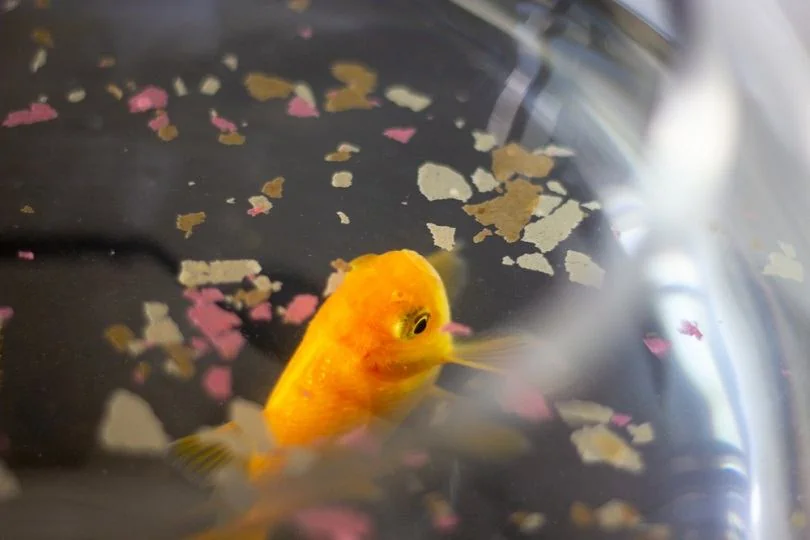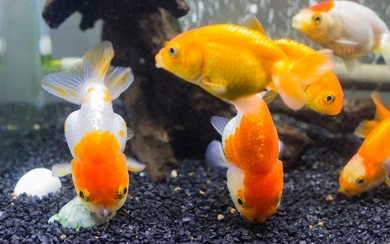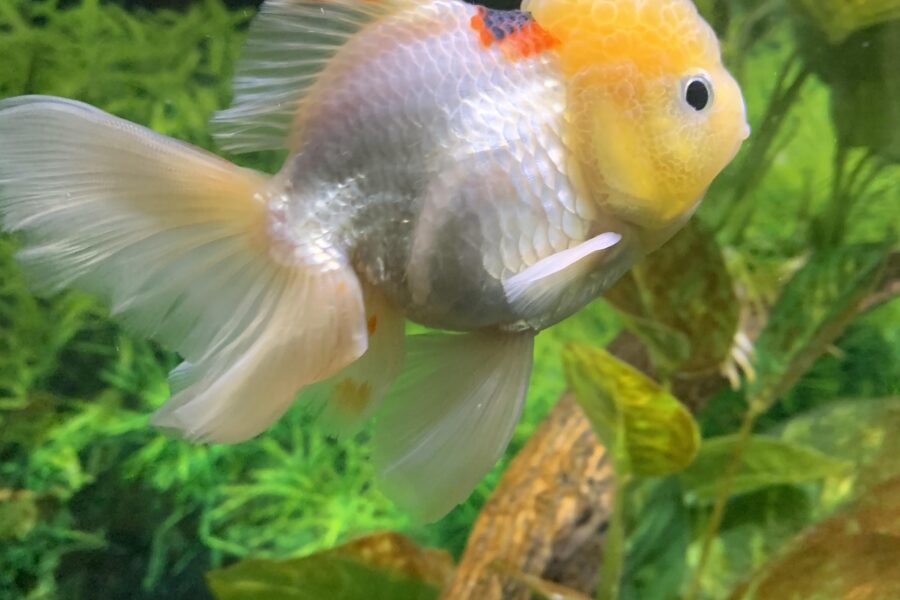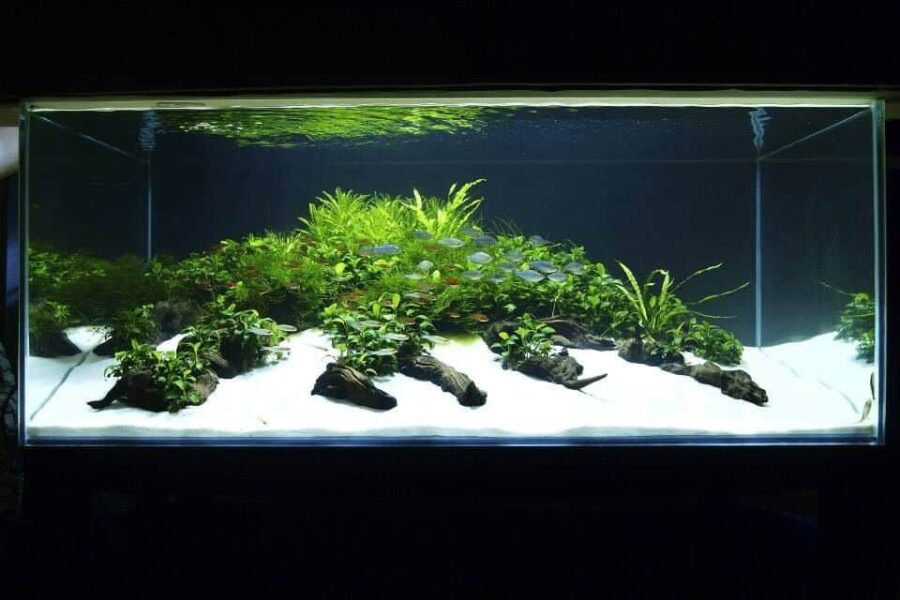
We often underestimate the significance of goldfish’s diet. They’re not merely decorative creatures. Instead, their nutrition parallels ours in importance. Just as constant burgers might plague us with health issues, an improper diet can cause problems for Goldfish too. It’s more than just maintaining their radiant colors or active swimming; a balanced diet can enhance their lifespan.
We need to pay attention to our goldfish’s diet as excessive feeding can lead to overweight fish, just like your missing office donut adds to your waistline. Carrying extra weight isn’t just a human concern; it can cause health complications for our little aquatic friends, including swim bladder disorder. It’s similar to you jogging with a heavy backpack every day – not a pleasant situation!
Therefore, understanding and monitoring our goldfish’s diet is crucial. We’re here to help you identify signs of overfeeding and promote your pet’s healthy life. Let’s delve deeper into this essential topic.
Identifying Overfeeding Indicators

You probably think beer bellies are only a concern for men of a certain age who coddle their lagers a smidgen too lovingly. Think again! Did you know goldfish are also prone to excessive roundness due to overfeeding? Now, that’s a thought to let swim around in your mind for a while.
Spotting Changes in Physical Appearance
While a plump goldfish might seem like a picture of roly-poly health, it’s often an unveiled SOS signal that you’re going overboard with feeding. A perfectly fit goldfish should have an overall streamlined look compatible with its streamlined lifestyle. If your little golden buddy looks like it has swallowed an oversized marble, you may be dealing with a case of overfeeding.
The overindulgence in food can also cause their scales to pop out, making them look like a pinecone. Because, who wouldn’t want to look like a tree seed, right? More accurately, it’s a condition called Dropsy – and it’s not as fun as it sounds. Remember, moderation is key.
As we dive into the deep end of your goldfish’s tank, the next indicator we’ll check out is its behavior. Because if there’s one thing fish are known for, it’s their intricate and complicated… swims.
Observation of Unusual Behavior

As subtle as your goldfish’s repertoire might seem, changes in behavior can also indicate overfeeding. Does your goldfish now prefer to hide away or stay immobile at the bottom of the tank? Or maybe it’s swimming erratically, appearing distressed? No, your goldfish doesn’t have an existential crisis; it’s more likely struggling with digestive complications due to overfeeding.
Ah, now that we have understood these visible signs, let’s look into something that isn’t that easy to see but speaks volumes about your goldfish’s health – water quality.
Detecting Water Quality Deterioration
Unaesthetic water changes may not just be a sign that your tank is turning into a small, aquatic dumpster. Uneaten food and increased waste (a direct result of overfeeding) can result in higher amounts of ammonia and nitrites in the water. This not only damages the beneficial bacteria in the tank but also poses a severe threat to your goldfish’s health. If your tank water smells like it could serve as a potent defense mechanism in case of a home invasion, you might be overfeeding your fish.
With these telltale signs of overfeeding, we learn that loving your pet too much “through their stomach” can lead to all sorts of problems. Now, you might be wondering, “How much should I actually feed them?” Well, stay tuned as we steer our submarine into the vast ocean of goldfish dietary requirements next.
Understanding Goldfish Dietary Requirements

While we might imagine that the entire kingdom of Goldfishia (that’s Goldfish-world to you and me) is abuzz with dreams of a buffet featuring an endless array of fish flakes, there’s more to the goldfish diet than most assume.
Different Types of Goldfish Food
In the culinary panorama of a goldfish, there are three main stars: flakes, pellets, and the occasional live or frozen treats. You see, flakes are like the fast food of the fish world – quick, easy, but not necessarily the healthiest if fed exclusively. Pellets, on the other hand, are the nutritious salads of the goldfish world; they pack in much-needed fiber and protein, making your goldfish feel Olympian! However, they sink to the bottom quickly and could lead to overeating if not monitored well.
Lastly, imagine this – your goldfish watching you devour that delicious bar of chocolate (you thought they didn’t notice, huh?) and wondering when it would have its cheat day with a little live or frozen treat. Daphnia, brine shrimp, and bloodworms are the ideal surprise for your goldfish’s cheat day, keeping the diet diverse and exciting.
Enough about the food categories, let’s dive into the pool of ‘How much?’ and ‘How often?’
Choosing the Right Food Portion Sizes
Now, we’re not implying your goldfish is a glutton, but let’s face it – they’ll eat as much as you give them. However, it’s your responsibility to ensure they eat right. And how do you do that? First, rule out that seconds are only for humans and not for goldfish. Portion sizes should be no more than your goldfish can chow down in about two minutes. Contrary to the popular belief that goldfish have a memory span of 3 seconds (I mean, who would forget food?), they can remember their last meal, and boy do they look forward to the next one.
Understanding Feeding Frequency
Just because your goldfish ogles at you with adorable eyes every time you pass the tank does not mean it’s feeding time again. A good rule of thumb is to feed them up to 2-3 times a day. Picture this: Breakfast, lunch, and dinner at Goldfish equivalent times. Remember that consistency is vital here—set times for their meals so your fish can slyly check its imaginary wristwatch but also for better digestion and overall health.
And as we swim to the shore of this segment, let’s not forget that understanding a goldfish’s dietary needs is vital. We’re not just aiming to avoid the sight of your goldfish float belly-up or the water turning foggy before your weekly cleaning; it’s about creating an environment where they thrive and live long, happy lives.
Next, we’ll jump into the cool waters of diet management tips of goldfish. Dive in with us, won’t you?
Tips on Management of Goldfish’s Diet

We’ve established that dietary games of ‘Pin-the-tail-on-the-donut’ are not suitable for our goldfish buddies. Now let’s focus on making sure we’re serving them the seafood Platter de Resistance instead of the aquatic equivalent of a fast food drive-through.
Ensuring a Balanced Diet
No one wants a Malnourished Marvin or a Deprived Denise swimming around their tank, so ensuring your goldfish has a balanced diet is crucial. High-quality flakes or pellets should make up the main part of their diet, but just like you wouldn’t want to eat the same thing every day, neither would your goldfish.
To maintain diversity in their diet, consider adding treats like daphnia, bloodworms, and brine shrimp to their feeding routine. All of these foods are important for their health and wellbeing. Imagine if you had to subsist only on chicken nuggets every single day (as tempting as that might sound to some). Variety is not just the spice of life, it’s crucial to ensuring a balanced diet.
Are you eager to discover the best types of food for your goldfish? Then don’t hesitate to dive into our comprehensive guide on the 5 Best Diet Foods for Your Goldfish. There, you’ll find detailed information to help you adapt the diet to your goldfish’s specific needs.
Feeling confident about your knowledge in this sector? Fantastic! Now let’s continue our plunge into understanding and adapting the diet to our goldfish’s needs!
Adapting the Diet According to Your Goldfish’s Needs
Have you noticed Angus the goldfish becoming more of a balloon or Scarlett slimming down zealously? Moments like these are when we need to tailor their diets according to their needs. Remember, younger fish are more active and need to be fed more often, while seniors may need less. Careful observation is the name of the game when it comes to adapting the diet to its needs. Are the fish performing their version of the Macarena too many times in the day? Reduce those snacks!
I know it feels like we’re smack in the middle of The Great Goldfish Diet Revolution, but hang in there, we’re moving on to some slick techniques to control this diet.
Using Feeding Techniques to Control Diet

To steer clear of having Chubby Charlie or Skinny Sammy darting around your fish tank, here are some neat tricks for feeding your goldfish:
- Use a Feeding Ring: This floating ‘food court’ stops the food from sinking and spreading. Your fish knows exactly where to find its meal, and you can monitor intake better.
- Feed in Small Portions: Break meals into smaller, more frequent servings. This would make you less likely to inadvertently have a Feed Fest Friday while ensuring Goldie gets adequate nutrition.
- Time their Meals: Goldfish are notorious snackers. To keep their diet in control, time their meals instead of leaving food readily available. Think of it as imposing a strict fish curfew.
Just when you thought we were done, we have one more stop! What to do when our piscine pals fall sick?
Dealing with Sick Goldfish
While we might wish our goldfish as invincible aquatic superheroes, they sometimes fall sick. Don’t panic! Most illnesses can be managed by adjusting diet and water conditions. Some ailment-specific food exists, like antibacterial food for bacterial infections or medicated food for parasitic infections. A complete diet overhaul isn’t usually needed; medication combined with improved nutrition shall work miracles.
All these steps guide a goldfish towards healthier, happier fins. Keep track of feeding, manipulate as needed, and be prepared to make changes if your finny friend isn’t feeling fin-tastic. Nevertheless, understanding the signals and adapting to change should have your goldfish swimming happily away to a healthier destiny in no time flat. Now isn’t that fin-tastic?! Next, let’s re-bait our knowledge hooks for the conclusion of our deep-dive into regular goldfish diet checkups.
Wrapping Up
Diving into the deep end of goldfish nutrition has been both educational and entertaining. Remember, overindulgence in goldfish food can result in not only physical changes and odd behavior in your aquatic friend but also degradation in water quality. Variety and balance in diet and proper feeding practices are crucial for their health and happiness.
Be observant for signs of dietary distress in your goldfish, like changes in appearance, unusual behavior, or deteriorating water quality. But remember, a diet doesn’t mean starvation, it’s about creating the right feeding habits to keep your goldfish swimming healthily.
As we bid goodbye to this amusing journey, let’s remember: A healthy goldfish is a happy goldfish. Let’s raise a flake packet toast to these fabulous creatures, wishing them a balanced and satisfying life under the water.
Frequently Asked Questions (FAQ)
Question 1: Why is it important for a goldfish to maintain a healthy diet?
Answer: A balanced diet ensures your goldfish has the right nutrients to grow, produce vibrant coloration, and resist diseases. Overfeeding can cause health problems and negatively affect the water quality in your aquarium.
Question 2: How can I tell if my goldfish is overfed?
Answer: Overfed goldfish may experience physical changes such as bloating and unusual swimming patterns. You may also notice deteriorated water quality due to excess food causing water pollution.
Question 3: What are the dietary requirements of a goldfish?
Answer: Goldfish need a balanced diet with carbohydrates, proteins, fats, vitamins, and minerals. The food should be in proper portions, and feeding frequency should be controlled to maintain their health and longevity.
Question 4: What types of food should I feed my goldfish?
Answer: Goldfish can consume specially-made goldfish flakes, granules or pellets, as well as vegetables and live or frozen foods. The type of food may vary based on the goldfish species.
Question 5: How often should I feed my goldfish?
Answer: Generally, it’s safe to feed your goldfish once or twice a day. However, you should feed them in small amounts they can consume in under two minutes and adjust the frequency as per their specific needs.
Question 6: How can I ensure my goldfish has a balanced diet?
Answer: Mix their diet up with a variety of goldfish-friendly food. This may include dry flakes or pellets, cooked vegetables, and at times, live or frozen food. Also, mindful feeding techniques can help control their diet.
Question 7: My goldfish is sick since I adjusted its diet, what should I do?
Answer: When sick, goldfish may need a softer, easily digestible diet. Consult with a vet for a plan that includes diet and any necessary treatments.



